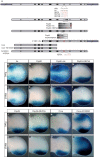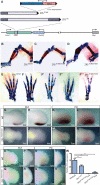Development of five digits is controlled by a bipartite long-range cis-regulator
- PMID: 24715461
- PMCID: PMC3978833
- DOI: 10.1242/dev.095430
Development of five digits is controlled by a bipartite long-range cis-regulator
Abstract
Conservation within intergenic DNA often highlights regulatory elements that control gene expression from a long range. How conservation within a single element relates to regulatory information and how internal composition relates to function is unknown. Here, we examine the structural features of the highly conserved ZRS (also called MFCS1) cis-regulator responsible for the spatiotemporal control of Shh in the limb bud. By systematically dissecting the ZRS, both in transgenic assays and within in the endogenous locus, we show that the ZRS is, in effect, composed of two distinct domains of activity: one domain directs spatiotemporal activity but functions predominantly from a short range, whereas a second domain is required to promote long-range activity. We show further that these two domains encode activities that are highly integrated and that the second domain is crucial in promoting the chromosomal conformational changes correlated with gene activity. During limb bud development, these activities encoded by the ZRS are interpreted differently by the fore limbs and the hind limbs; in the absence of the second domain there is no Shh activity in the fore limb, and in the hind limb low levels of Shh lead to a variant digit pattern ranging from two to four digits. Hence, in the embryo, the second domain stabilises the developmental programme providing a buffer for SHH morphogen activity and this ensures that five digits form in both sets of limbs.
Keywords: Limb development; Long-range regulation; Mouse; Sonic hedgehog; ZRS.
Figures





References
-
- Blanc I., Bach A., Robert B. (2002). Unusual pattern of Sonic hedgehog expression in the polydactylous mouse mutant Hemimelic extra-toes. Int. J. Dev. Biol. 46, 969-974 - PubMed
Publication types
MeSH terms
Substances
Grants and funding
LinkOut - more resources
Full Text Sources
Other Literature Sources
Molecular Biology Databases

